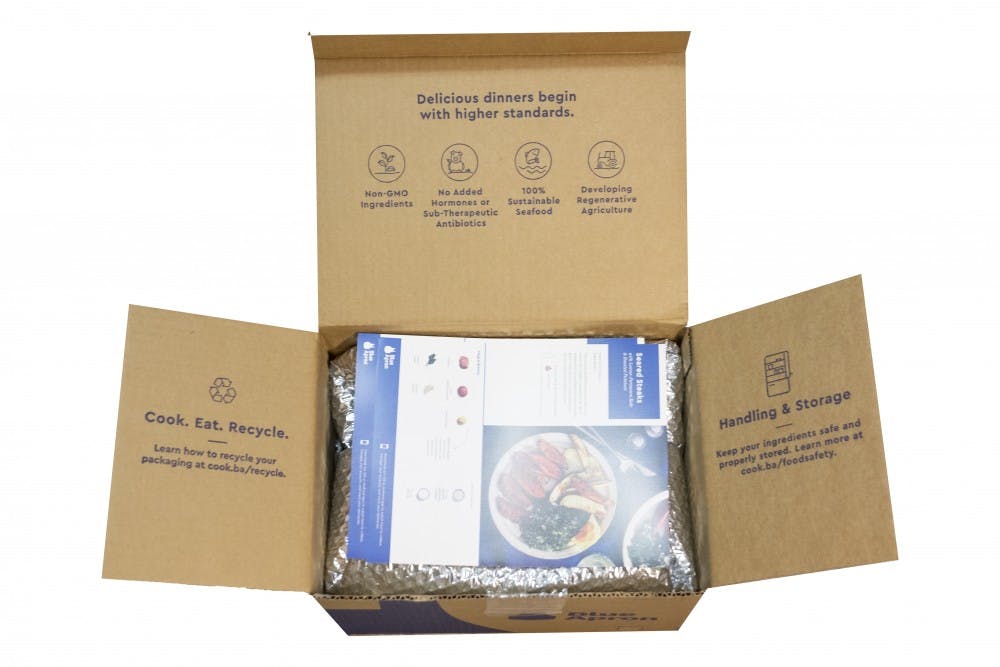Cooking can be a complicated affair as a college student. Not all of us are in line to be the next Gordon Ramsay, so deciding on recipes and buying all of the ingredients can exhaust the typical student. This is all before one can even think of spending the next half–hour to an hour actually putting the meal together.
Meal kit delivery services have been designed to eradicate the first two steps in the cooking process. Their purpose is to create convenience for their busy customers without sacrificing the quality of a home–cooked meal by delivering fresh ingredients, portioned according to the accompanying recipes, to your doorstep every week.
Companies that offer them include Blue Apron, HelloFresh, Plated, Sun Basket, Green Chef, and more. They vary in number of recipe options, types of subscription plans, price for a two–person box with three meals a week, and shipping costs. For example, Sun Basket offers “Paleo, Lean & Clean, Gluten–free, Vegetarian and Vegan options.” Green Chef takes it an extra step with a keto–friendly plan, perfect for anyone on a ketogenic diet.
An immediate positive about a meal kit delivery service is the expansion of your cooking repertoire. Impress your friends with surprisingly easy–to–make meals like Blue Apron’s “seared cod & olive tapenade with kale & brown rice” or Sun Basket’s “pineapple fried rice with braised tofu, water chestnuts, and togarashi.” You could even make a date out of it. Most recipes have stated preparation and cooking times that range from 20–45 minutes.
To entice future customers, most meal kit companies offer a free or discounted trial. Mikayla Joseph (N '20) got a box with two meals in it for her free trial from Blue Apron. She appreciated that she didn’t have to go grocery shopping, but the main issue was that she didn’t cook often enough.
“In theory it’s really nice but it wasn’t something I was willing to pay for. I had to block out a time for when I was going to cook a whole meal,” she said. “I liked the food but it was too much work and too much money to be something I’d regularly do.”
Rebeca Maia (C ’18) was also gifted a free Blue Apron box from a friend, who received $10 off when Maia subscribed for the service. She used it for a month before cancelling, noting that the friend and her roommate had both ended up cancelling their plans after a short period of time as well.
She wanted to try it out for the educational experience of being introduced to recipes and cooking tips, like what different spices work well with different types of foods. She admits that some of the recipes she received weren’t necessarily in line with her personal tastes, and basic protein offerings like chicken and steak became “repetitive in the ways you could cook them.”
She wasn’t sure how to handle the protein, as the boxes didn’t come with freezing instructions or information on how long the ingredients would be good for. “I would have to freeze the protein because I got it on Saturdays and usually didn’t feel like cooking it on the same day that I got it. It would be this whole ordeal,” she said, citing the difficulties of juggling plans with friends on nights that she’d been preparing to cook. “It honestly ended up becoming more of a chore of sorts,” she said.
However, because “all the recipes require little things,” Rebecca realized that the small portion sizes incentivized her to cook more often—it was unlikely that she would cook the recipes without the meal kit service: "[I was] not trying to get a whole bottle of red wine vinegar to use every once in a while.” She did learn how to make sauces, and thinks that she could possibly recreate the recipes in the future.
Of course, one’s experience with a meal subscription service will depend on numerous factors. For example, a single serving might work for an average person, but not for someone who runs marathons as a hobby.
Plus, the recipes often work best with two people cooking—and not everyone has a personal sous chef. Another person helping in the kitchen definitely cuts down the cooking time. The step–by–step recipes don't often take into account the extra time that an inexperienced chef will take to chop the vegetables or clean the counters. That prep and clean–up time, plus the amount of time one has to set aside to cook, is probably not the ideal equation for someone who may already be struggling to grab a sandwich between classes and clubs.
But as these services generally offer three meals (with two to four servings each) per week, it’s not impossible to balance three home–cooked dinners with four dinners spent out with friends or on–the–go. With the variety of meal plans offered by different companies, it should be easy to find one that’ll suit your lifestyle and tastes. Domesticity and adulthood, here we come.







